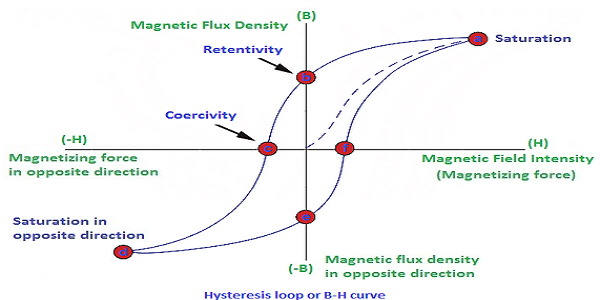What is Hysteresis?
Hysteresis occurs in a system that involves a magnetic field. Hysteresis is the common property of ferromagnetic substances. Generally, when the magnetization of ferromagnetic materials lags behind the magnetic field this effect can be described as the hysteresis effect.
Definition:
The meaning of hysteresis is ”lagging”. Hysteresis is characterized as a lag of magnetization intensity (B) behind the magnetic field intensity (H).
All ferromagnetic materials exhibit the phenomena of hysteresis. To give you a better understanding of the concept, we will take an instance where a ferromagnetic substance is placed inside a current-carrying coil. Due to the magnetic field that is present the substance gets magnetized. If we reverse the direction of current then the substance gets demagnetized, this process is known as hysteresis.
There are two types of hysteresis;
- Rate-dependent hysteresis
- rate-independent hysteresis
Hysteresis Loop
The hysteresis loop shows the relationship between the intensity of magnetization and the magnetizing field. The loop is generated by measuring the magnetic flux coming out from the ferromagnetic substance while changing the external magnetizing field.

Looking at the graph, if B is measured for various values of H and if the results are plotted in graphic forms then the graph will show a hysteresis loop.
- The intensity of the magnetism (B) is increased when the magnetic field (H) is increased from 0 (zero).
- With increasing the magnetic field there is an increase in the value of magnetism and finally reaches point A which is called saturation point where B is constant.
- With a decrease in the value of the magnetic field, there is a decrease in the value of magnetism. But at B and H are equal to zero, substance or material retains some amount of magnetism is called retentivity or residual magnetism.
- When there is a decrease in the magnetic field towards the negative side, magnetism also decreases. At point C the substance is completely demagnetized.
- The force required to remove the retentivity of the material is known as Coercive force (C).
- In the opposite direction, the cycle is continued where the saturation point is D, retentivity point is E and coercive force is F.
- Due to the forward and opposite direction process, the cycle is complete and this cycle is called the hysteresis loop.
Advantages of Hysteresis Loop
1. A smaller region of loop hysteresis is indicative of less loss of hysteresis.
2. Hysteresis loop provides a substance with the importance of retentivity and coercivity. Therefore the way to select the right material to make a permanent magnet is made simpler by the heart of machines.
3. Residual magnetism can be calculated from the B-H graph and it is, therefore, simple to choose material for electromagnets.
